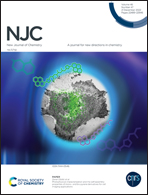Construction of NiCo-LDH/g-C3N4 heterojunctions as efficient photocatalysts for enhanced degradation of tetracycline hydrochloride and hydrogen evolution†
Abstract
Realizing highly efficient utilization of solar energy for solving problems of environmental pollution and energy shortage has attracted increasing attention. Herein, Z-scheme two-dimensional (2D)/2D NiCo-LDH/g-C3N4 (LDH/CN) heterojunction composites were synthesized, which showed enhanced photocatalytic performance for tetracycline hydrochloride (TC) degradation and hydrogen (H2) generation under visible light irradiation. A 2D/2D heterojunction structure was formed between NiCo-LDH nanosheets (LDH) and g-C3N4 (CN), which was beneficial for the effective separation of photogenerated charge carriers. The active species of hydroxyl (˙OH), superoxide (˙O2−) and hole (h+) radicals contributed to TC photodegradation. The optimum photocatalyst showed a remarkably enhanced photocatalytic capability with a hydrogen generation rate of 451.7 μmol g−1 h−1. The improved photocatalytic activities may be attributed to the synergistic effects of the increased absorption of visible light, the separation efficiency of carriers and the 2D/2D heterostructure. A Z-scheme photocatalytic mechanism was proposed for the LDH/CN composite, showing dual advantages of a high redox ability and efficient charge carrier separation.



 Please wait while we load your content...
Please wait while we load your content...